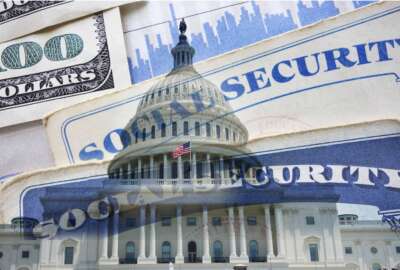Insight by FEBA
Planning for federal retirement? Here’s how, and when, to get your documents in order
Applying for federal retirement is a complex process. Here’s a breakdown of what paperwork you need, when you need it, and what comes next.
Soon-to-be-retirees often look forward to the simple life, like traveling, relaxing, enjoying hobbies and the company of friends and family, without the pressures and complexities of working. But federal employees nearing their retirement date have one last complex work-related hurdle to clear before they can enjoy that simple life that they earned: the federal retirement process itself. There’s a lot of paperwork and process to complete in order to culminate a career in public service. Many feds find this difficult to navigate, so here’s a quick guide to help get them started.
When to start, and what you need
Justin Pierce and James Campbell, both fiduciaries and Federal Retirement Consultants℠ with the Federal Employee Benefit Advisors, said the best time to start seriously thinking about it is roughly five years from retirement. That’s also the best time, they noted, to contact a Federal Retirement Consultant℠.
“I would say, the sooner, the better,” Campbell said. “For sure, once you’re getting within five years of retirement is a great time to start to talk with one of us, or definitely once you get 59.5 and older. Even if you think you’re going to work maybe until 70, there are some strategies that we can start to help you with to maximize your retirement.”
Estimated annuity statement: Aside from that, the first thing a federal employee planning to retire will need to do is request their estimated annuity statement. This document takes into account years of service, projected salary during your three highest-paid years, and an estimate of what you would get from your annuity if you retired on a certain date. This doesn’t lock you into specifics, nor will it draw negative attention from agency leadership; it’s purely informational, a best-guess look at what you can expect from federal retirement.
This document can be requested multiple times, either from the Government Retirement and Benefits (GRB) platform, or directly from human resources. The final time you request it should be about six months before your retirement date, as much of the information transfers directly over to retirement forms.
SF50: The next form to request, also about six months before your retirement date, is the SF50: Notice of Personnel Action. This will be a record of the entirety of your career, from your start date in federal service and what grade you started at, through pay raises, step increases and locality adjustments — everything needed to calculate your retirement and annuity.
Federal employees planning for retirement can also get this form from GRB or HR.
“It’s not a bad idea to [review the SF50] when you’re six months out, just to see that everything is correct, because OPM does make mistakes. They’re human too. So if you can correct it sooner, then it’s a little bit easier than having to go back,” Pierce said.
SF 3807 and SF 2801: These are the actual federal retirement forms that will be submitted to the agency. SF 3807 is for Federal Employee Retirement System (FERS) employees, is about 15 pages long, and requires feds to make big, permanent decisions about some key retirement benefits. SF 2801 is somewhat longer, and for Civil Service Retirement System (CSRS) employees, but is otherwise comparable.
These are the forms that will pull data directly from the estimated annuity statement. But Pierce and Campbell cautioned that these are very difficult documents to get right the first time; paperwork errors are the most common cause of retirement process delays. Consultants like FEBA’s can help ensure that these documents are filled out correctly and completely.
SF 2818: Prospective retirees will also need to complete their Federal Employee Group Life Insurance (FEGLI) retirement form (SF 2818), which will determine how they take their life insurance into retirement. The Office of Personnel Management encourages retirees to confirm their beneficiaries and review survivor benefit options at this time as well.
What comes next?
All of this paperwork, Pierce and Campbell said, should be submitted to the agency as early as allowed, usually 90 days before retirement. This gives the agency as much time as possible to process it, because there will be delays, Campbell said. Then on the date of your retirement, that packet goes from your agency to OPM. OPM does have a processing backlog; it can take up to 90 days for them to begin processing your retirement packet.
Retirees can expect their first, estimated annuity payment within two to three months. OPM refers to this as “interim” pay: Usually, it’s about 60-70% of what your actual annuity will be. More is held back than is actually required for projected taxes and benefits payments while the exact calculations are happening. Once those calculations are finished, the total amount underpaid will be paid back.
That’s why it’s important to save up a lump sum ahead of retirement to cover those first few months between the last paycheck and the first full annuity payment. Many federal employees will save up annual leave time, which is paid out in one lump sum at the end of your employment, to help get over the hump. Others rely on the Thrift Savings Plan accounts, but it’s important to remember that it will be two to four weeks before TSP recognizes you’ve retired; during that time, there will be a blackout period where you won’t be able to withdraw money. So if TSP figures into your early retirement plans, it’s important to withdraw what you need before actually retiring.
But the main thing prospective retirees need to remember to make this process as quick and painless as possible is to fill out the paperwork correctly.
“One of the biggest things that’s going to cause you delays in your retirement processing is incorrect or incomplete paperwork,” Campbell said. “This happens all the time, and this is what really slows down the process.”
Free Federal Retirement Benefits Trainings
Register here for an upcoming webinar
- Strategies For TSP Maximization
- Forms Needed For Retirement
- FERS/CSRS Pension
- Special Retirement Supplement
- Survivor Benefits
- FEHB (Health Benefits)
- FEGLI (Life Insurance)
- Social Security Maximization
- *All events include an interactive Q&A Session
Copyright © 2025 Federal News Network. All rights reserved. This website is not intended for users located within the European Economic Area.





